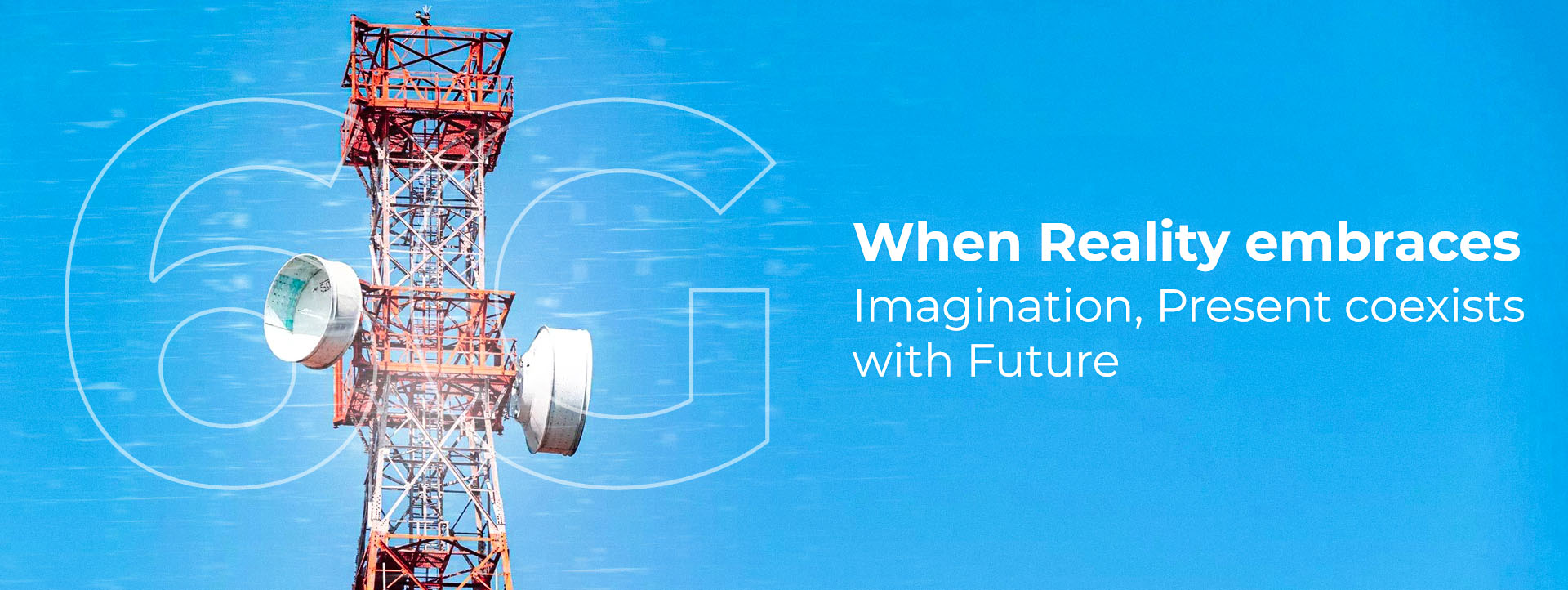- 6G Revolution
- Telecom
- Spectrum
- Mobile
6G: When Reality embraces Imagination, Present coexists with Future
04 March 2024 • 4 Mins Read

What is 6G?
6G is the next generation of mobile networks, following on from 5G. Now, instead of reducing it to general semantics, let’s try to comprehend what it really is and why we should care. To start with, try envisioning a world where we can download anything and everything, right from a full-length Grand Slam Final match to a 4K resolution movie in less than a second, what a boon that would be for us - Tennis Lovers, ditto cinephiles. Now, that’s just one part of it, there is certainly more to this than meets the eye. It's about laying the groundwork for the Internet of Everything (IoE), where the network becomes a seamless fabric of interconnected devices that not only communicate with us but also with each other. It’s a world where we can interact with holograms, explore, and enhance the nitty grittiest of Virtual reality, offering a digitally immersive experience like never before. On delving deeper into it, we find ourselves in a world where we can control devices and machines with our thoughts, equipped with machines that are interconnected and intelligent too, and this is not even a science fiction, it is the future of 6G beckoning mankind.
Features of 6G
A significant chunk of 6G research centers around not only transmitting data at Ultra High frequencies (UHF) utilizing the untapped capabilities of unused spectrum, but also optimize their efficiency. To add to it, 6G may also look to machines as an amplifier for one another’s data thereby allowing devices to expand coverage on top of using it. Moreover, 6G is expected to be the backbone of future digital economies, enabling new forms of communication like three-dimensional holographic communication, high-precision manufacturing, and advanced wearable technology networks. This is the closest answer to the burning question of the need for 6G when 5G is already a huge upliftment over its predecessors in terms of speed of transferring data which is often of utmost interest.
Advantages of 6G Technology
Ultra-Low Latency
6G will have much less latency than 5G (of the order of 100, bringing it down to less than 100 microseconds) intensifying Augmented Reality (AR) and Virtual Reality (VR) usage.
Energy Harvesting
Aims to enable devices to synthesize energy from vibration, light, and temperature gradients, eliminating battery charging and deployment shortcomings.
Advanced AI/ML Integration
Improve already existing Self Learning and Healing capabilities of AI/ML defined native air interfaces.
Expanded IoT Applications
Expanding IOT use cases ranging from Logistics, Agriculture, Environmental monitoring, Telehealth etc.
Enhanced Security
Leveraging on Advanced Encryption technologies and Artificial Intelligence based security measures to keep data safer than how it used to be.
When will 6G come out?
Now that we know how capable 6G is and the way it can shape our life in general, it must be tempting to step into a future that promises enormous opportunities. Embracing the future, 3GPP and partners ARIB, ATIS, CCSA, ETSI, TSDSI, TTA, and TTC unite to forge the path to 6G. With Release-21 marking the dawn of 6G by 2028, this global collaboration is set to revolutionize connectivity, merging digital and physical realms, and unveiling a new era of innovation and inclusivity. Qualcomm has floated a 6G development plan with 2030 as a projected Rollout date which echoes Ericsson’s 6G messaging deployment timeframe. Coverage may depend on your geographic location. As of now, China is the only country to have launched first 6G Satellite.
Disadvantages of 6G Technology
Architectural Constraint
As 6G uses cell-less architecture and thrives on multi-connectivity, the pain point here is to design the new architecture, where User Equipment (UE) connects to the Radio Access Network (RAN) and not to a single cell.
Spectral Limitation
Terahertz (THz) waves which 6G spectrum aims to utilize, are very sensitive to shadows and susceptible to free space fading, all of which calls for Ultra-large-scale antenna which is a major challenge.
Persisting Issues
Drawback of Visible Light Communication (VLC) also needs to be taken into consideration, because 6G uses visible light frequencies for part of its communications.
Lack of Standardization
Lack of uniform standards and protocols across Telecom industry since it still is in Planning stage.
Vulnerabilities
6G's expanded capabilities increase vulnerability to cyber threats, necessitating enhanced security in interconnected, intelligent networks.
Design Challenge
Designing circuitries of network and terminal equipment for low energy consumption.
Mastering the Challenges: Pioneering Solutions for 6G's Future
In addressing the complexities of 6G technology, the industry is embarking on a transformative journey. The shift to a cell-less architecture heralds a new era of seamless, multi-connectivity, empowering devices to interact with the Radio Access Network (RAN) directly. Specialists are tackling the sensitivities of THz waves and VLC by engineering groundbreaking ultra-large-scale antennas and sophisticated modulation techniques that promise resilience and efficiency. Global collaboration is pivotal, as experts across borders unify to forge comprehensive standards and protocols, ensuring 6G's interoperability and security. The quest for enhanced cybersecurity and energy efficiency in 6G is inspiring ingenious solutions, positioning this next-gen technology as the cornerstone of a sustainable, interconnected future.
Conclusion
While 6G is a tantalizing prospect in transforming wireless technology domain and beyond, we cannot just downplay it as a successor of 5G, it is a revolution that can change the history of humankind in a way that we cannot fathom. The Global 6G market size and share revenue is expected to reach around USD 40.5 billion by 2032. It remains to be seen how prepared we will be when 6G comes knocking at our doors, especially as we stare at compatibility issues which need to be touched upon. A key aspect to monitor will be the retail pricing per GB of data versus the network cost per GB, as this margin is crucial for telecom operators' profitability. Initially, the ratio may start favourably high but tends to decrease over time. To sustain revenue, operators must explore unlicensed bands and areas like precision healthcare, smart agriculture, and digital twin technologies, ensuring growth in ARPU and preventing potential financial strain, Unlicensed Frequency bands come with limitations of their own like Higher Congestion and Reduced security.
As always, there will be entities playing foul. A set of protocols and new regulatory need to be agreed upon across the verticals to secure privacy. However, forsaking all excitements at these exploits of 6G in the name of “perspective” would be joyless. Similarly, procrastinating about the concerns around 6G for no reason other than extrapolating an unknowable future, is equally meaningless. Time stubbornly marches on, and the future will likely be upon us sooner than we would prefer. All we can do right now is wait and see how drivers of this phenomenon called 6G maneuver themselves through the ever-evolving technological matrix.
Author

Agniv Banerjee,
Associate Solution Engineer
My passion lies in documenting the evolving innovations within the dynamic realm of Communication, focusing on areas such as Cloud Engineering, TM Forum ODA, 4G LTE networks, and Billing, through insightful blog posts